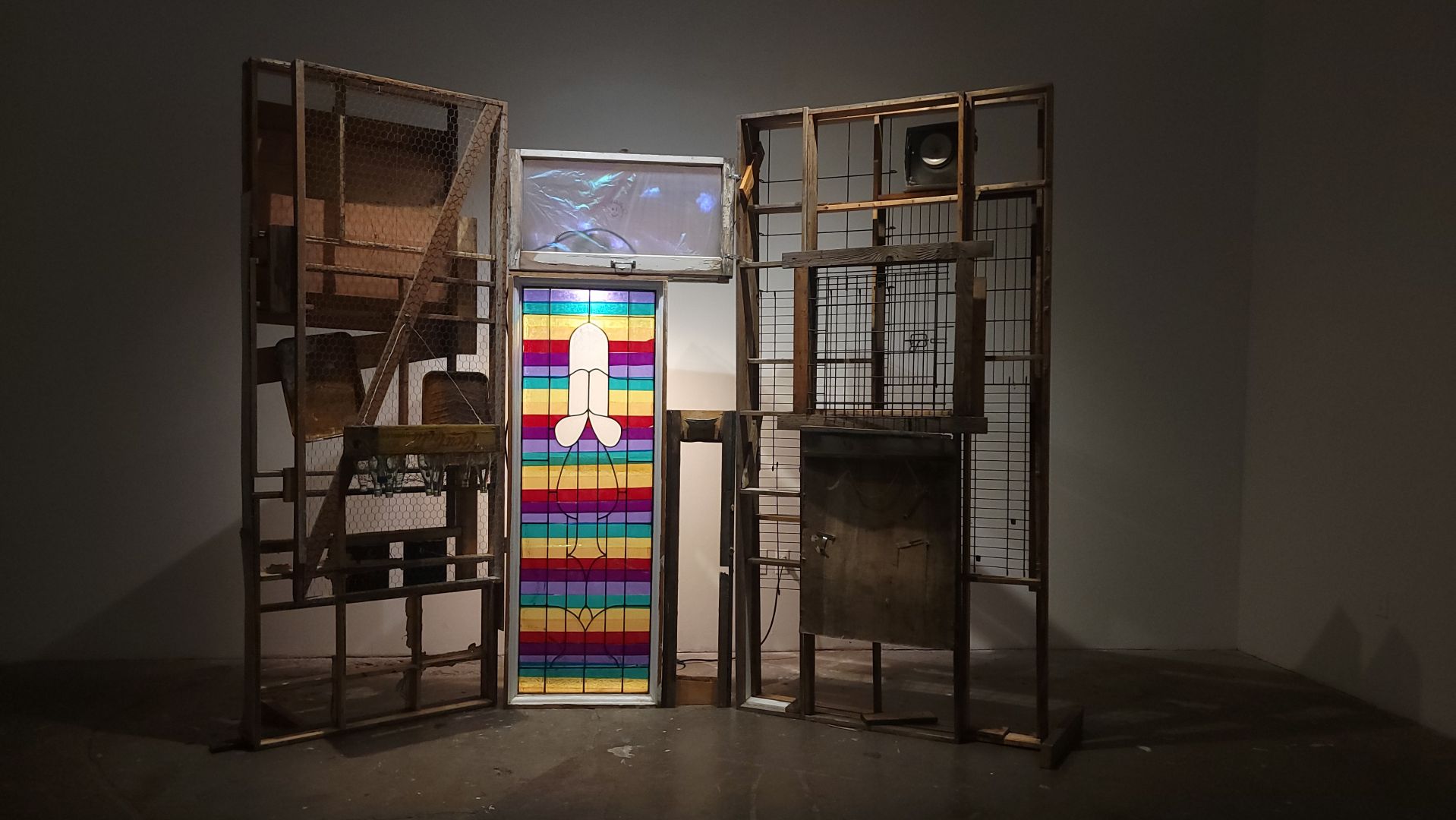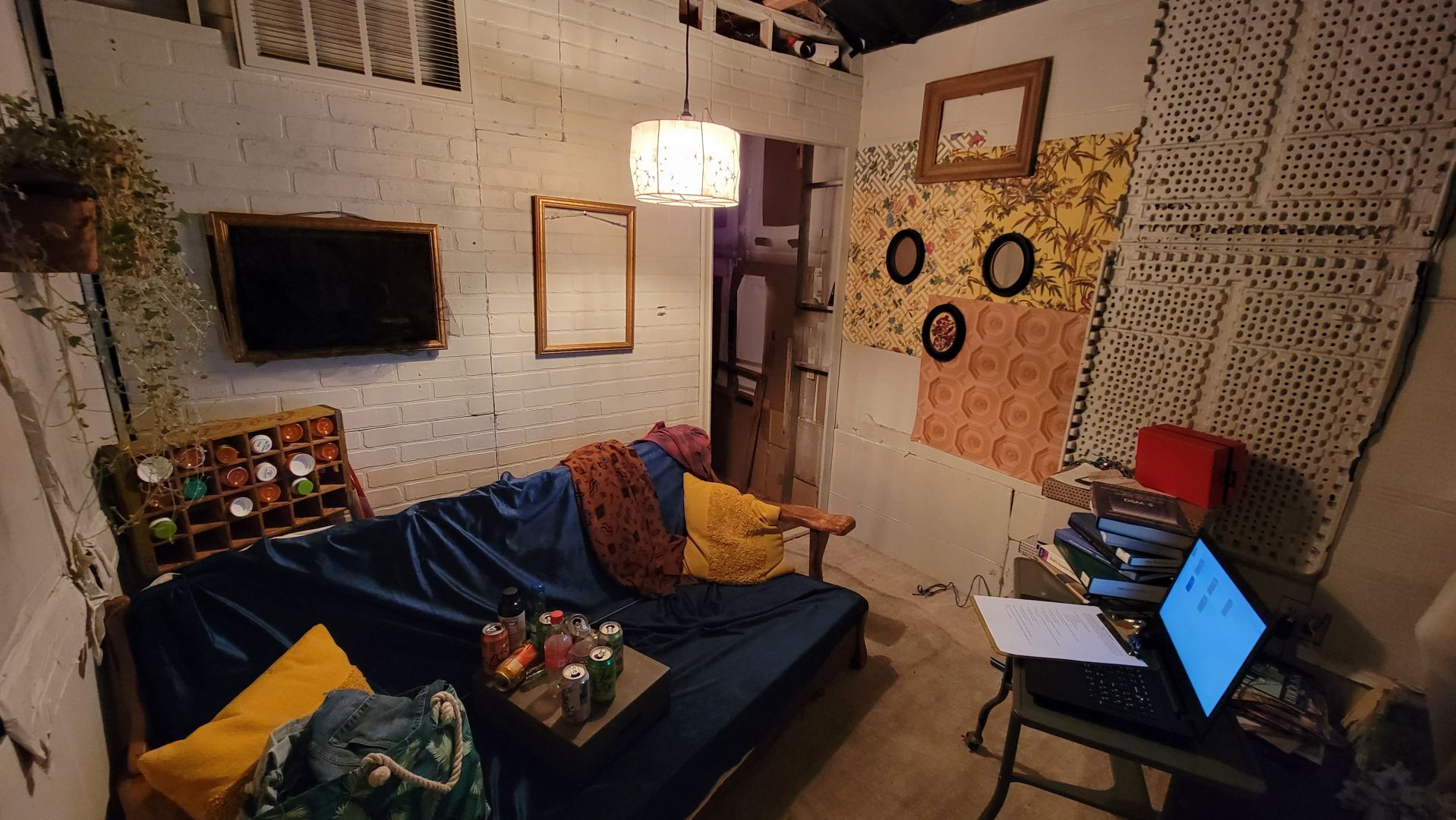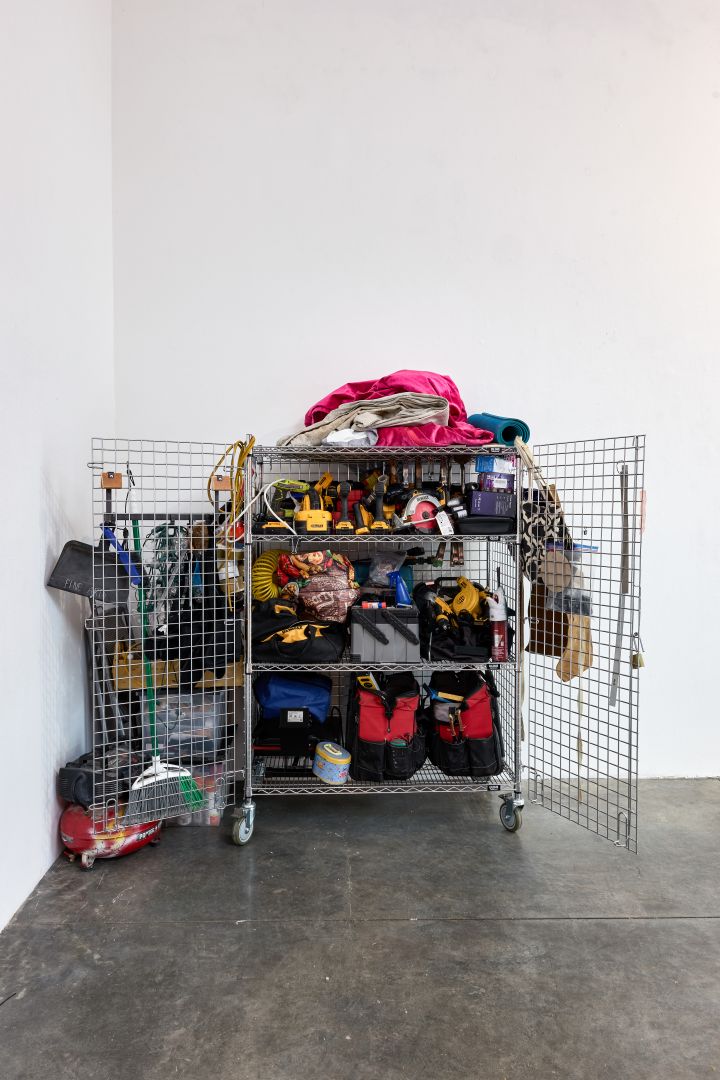Meet Ali Minette | Artist, Builder, & Fabricator


We had the good fortune of connecting with Ali Minette and we’ve shared our conversation below.
Hi Ali, how has your work-life balance changed over time?
I returned to school in 2020 to do an MFA, after having worked in the entertainment industry for over 10 years. How I spend my time has shifted dramatically since returning to school in stark contrast with those 10 years, so I feel like it’s important to share some backstory to highlight the differences. Just before I finished my BFA at CSU Long Beach, I began working at an entertainment industry fabrication shop that specialized in blacksmithing (my focus at CSULB). We worked on everything — Movies, TV, commercial and music videos — making props and costume pieces from various metals. I quickly learned that the expectation for labor was working until the job was done, whatever that required. My very first job with them was the fabrication of a prop for a Marvel movie, but aside from being able to retell the story all these years later, it was not glamorous or novel. I remember the day before we had to deliver the prop, I drove to Burbank from my home in Long Beach, worked from 8am until 5am the next morning (a 21-hour work “day”), drove back to Long Beach to shower and then caught a 10:30 am flight out of LAX to Brazil to follow through on a trip my friend and I had planned months before. In the production culture of TV and film there is no flexibility to have a life, you either do the job when the job is happening with the circumstances prescribed to you or someone else will do it. It’s a toxic culture that is perpetuated and sustained through that mentality of “if you don’t take this job, someone else will”, regardless of whether your apprehension is due to poor pay rates, existing obligations (like family, dependents, or juggling other work to afford life in LA), or due to egregious disregard of labor/ OSHA laws. I left that shop a year later and began working on set in TV production where the standard work week is 60 hours, typically 12 hr days. But add in an hour meal and frequent overtime, we would be on set 14-16 hours a day. That leaves so little time for anything else, certainly no time on a work day, and the burnout was real. My weekends were mostly sleeping in to recover. TV production is notorious for the “Fraturday” which is when you start work later on Friday due to the unscheduled overtime and required turn around throughout the week, then you end up working into Saturday morning. Monday would reset with a calltime between 6-8a unless you are on a show that is mostly overnights, leaving you with an incredibly short weekend.
To get back to the heart of this question, now that I have the flexibility of an artist who is creating my own works and following my own timeline, that is an entirely different relationship to time and labor. I do still fall into that work-all-night mentality when something needs to get done, but that is not my daily life and I’m not beholden to someone else’s scheduling. Now, I am able to take my step kids to school, be around for events or to make plans that I won’t cancel due to burnout or a filming day that runs long. I value this freedom particularly after having so little autonomy in my schedule for years, it was either yes or no, and often when you say “no,” it means you stop getting calls. I also think being able to frame the work I do now as putting energy into myself and my community and the things that matter to me, makes it feel less like work and more like actual living.


Can you open up a bit about your work and career? We’re big fans and we’d love for our community to learn more about your work.
I don’t really believe in the idea that I am apart from other folks in the creation of my art. Getting here has been a long process of learning from other people and exploring ideas sparked from experiencing the world around me. I do think I make work that will reach different audiences than artists exploring the same conceptual ideas, purely because aesthetics are subjective. My artistic journey began in childhood and feels like the tools and knowledge I have picked up over the years are only now coalescing. I mentioned briefly in one of my other responses that I struggled through my undergrad program; at 38, when I was in my first semester of my MFA, I was diagnosed with ADHD. I finally had a framework for why certain things that seemed so easy for other people felt nearly impossible for me. This wasn’t an immediate revelation, rather it came on as I learned more and more that my experiences were shared with and also commonly occur for other neurodivergent folks. Naturally this new understanding of myself and my experiences as a queer person have deeply informed my practice. I’ve realized that making personal work, even in very abstract forms, is much more effective in reaching people on an emotional level. Ultimately connecting with the individual is how we can compel change and engender compassion across lived experience. I think art is really powerful in that way, how it can change a viewer’s perspective. As an artist, my goal is to be a storyteller and my work is personal across the entirety of my practice, from fabrication to an ongoing interaction with the materials. I take that on literally by living with my installations, being the part that bridges the gap between experience and understanding.


Let’s say your best friend was visiting the area and you wanted to show them the best time ever. Where would you take them? Give us a little itinerary – say it was a week long trip, where would you eat, drink, visit, hang out, etc.
That’s a hard one, I’ve lived in LA for nearly 20 years, and I’ve been all over. I forget about places until I drive by them again, but I will try to be a good host. Let’s break down by areas.
Starting in Long Beach, the beach itself is not a high point of SoCal, but the city is amazing. I always thought of it as the chill of San Diego with the excitement of LA, there are so many cool queer places and people and it’s super diverse and friendly. LA as a whole is diverse in terms of numbers, but statistics often don’t tell the whole picture, and I think LB is a fairly accurate representation of the people living across LA county. We would have to hit MoLAA to see some art, Hamburger Mary’s for a drag show (she and I have history since 2003), and pizza at 4th horseman. Also a huge fan of The Attic, clearly this itinerary will involve a lot of eating, drinking, and art. Sweetwater Saloon for some cocktails and pool. Cruise around Retro Row look at some shops. Not in that order necessarily. Catch something at the Art Theater. Ride bikes along the boardwalk.
Hollywood – I have some sort of trendy favorites – Davey Waynes and Jumbo’s Clown Room. The Magic Castle, if I can get the tickets; I have a magician friend who lives out of town, but is usually able to hook up an invite. LAXART. LACE. Probably try to get onto the Paramount lot, but it’s been hard to bring guests during covid. Now that restrictions are lifting it might be easier. The Hollywood sign, I’ve actually never done the hike up to the sign, but it’s been on my list forever and this is a good excuse. Griffith Observatory at night, the views are stunning. Hollywood Blvd, to people watch and grab a drink at Boardners.
Westside – Santa Monica Pier at night, Venice Boardwalk – weekend evenings are when there is a big drum circle, but there is always something interesting happening, Bodega cafe/ wine bar, ramen at Tsujita Annex, NuArt for RHPS – it’s probably been over a decade since I’ve gone. Bergamot Station, I love getting the variety of works in one spot.
DTLA – Coinbase Center for an event, honestly it doesn’t even matter what sport, I am not a sports fan unless it’s rugby or the summer olympics, but I saw a hockey game there and it was electric. Grand Central Market. Chinatown (Central Plaza and Bubble U, I love boba, there are also some small galleries tucked away in there that usually have pretty interesting work), Oliveras St, Traction Ave/ arts district- EightyTwo- a cool barcade, 1st street in little Tokyo – more ramen at Daikokuya Little Tokyo, MOCA at Geffen, Redcat. There is this random wholesale leather supply place on the fringes of the garment district that has full hides, but also scrap bins of cut offs from leather goods manufacturing in so many textures, weights and colors – I love the scraps! The garment district is also a really cool place to wander, you can walk a few blocks and go from clothing to fabric to bead to floral supply. A little further and you will find the toy dist which ironically (or maybe not) borders where all the glass pipe, vape and other paraphernalia stores are located. There is a street that is all soccer supply, which gives me a laugh. I found it originally because I was shopping for a show and needed some particular soccer gear for a scene. There is also a block on Olympic near the fruit wholesale bldg that is all party supply and piñatas hanging from the rafters, I used to frequent that street a lot. There is also the Row which I think the name is somewhat questionable, but I enjoy Smorgasburg which happens there. The America Apparel factory used to be in a building there, it was pretty cool, you could go into the store and buy clothes and have them silkscreened while you waited. The other buildings were all condemned or partially condemned, the first (very low budget) production I worked on filmed at a very run down studio in one of the partially condemned buildings on floors that were “safe”, Brazers was their biggest client if that informs the aesthetic you are picturing. They had a variety of sets and were in DTLA where we were filming the majority of our movie.
There are so many more places I can think of, but I think we have well surpassed our ability to hit all these places in a week, but I will throw in that part of what I love about LA is proximity to different natural spaces. I really enjoy hiking and there are a lot of places within a 30 mile radius to do that. Malibu, Angeles Crest, and more local Runyon Canyon, Griffith Park (particularly on the Crystal Springs/ merry-go-round side) Fryman Canyon.


Shoutout is all about shouting out others who you feel deserve additional recognition and exposure. Who would you like to shoutout?
My parents were my original cheerleaders, and have continued to support my pursuits in the arts. My mother is still my biggest cheerleader and comes to all my events to show her support. My father passed away in 2015, and was also very pragmatic in regards to having a security net (career options). I think my myriad interests were encouraged for that reason, having a diverse set of skills meant I was prepared for a lot more things and would have more options for employment, this coming from a generation where you got a job with a company and worked there for your entire career. However, those various skills really benefited the work I did in production, which looking back on it, feels like the security net job. My current practice is very much informed by my experience in production, so I wouldn’t take any of it back, but I do think it needs a major overhaul, like most for-profit industries under capitalism.
My partner, Tara Pixley, who is a working visual journalist and scholar, is the person who saw my desire and potential to return to school for my MFA and encouraged me to do so. She was instrumental in the whole process, I wouldn’t have been able to get through the application if she hadn’t gassed me up and edited all of my statements. I struggled through my undergrad program and the idea of returning to school was daunting, but also something I had kept in the back of my mind since completing my BFA. I have immense respect for her and all the work she does, she is not just an amazing partner or motivator, but she is also someone I look up to. She is a person who walks the walk and does a lot of time consuming work to make media and visual media more equitable, both behind and in front of the lens.
The professors at Otis across the board have been amazing. The structure of the program really helped me get to a place of confidence in the work I’m making, talking about that work, and in my writing. I have had so many generative conversations with professors that pushed my work to a place that is both more personal and more accessible to a wider audience. In no particular order the following professors have been instrumental in the maturing of my practice both through our conversations and through their own practices: Jennifer Moon, Asher Hartman, Andrea Bowers, Kathrin Burmester, von curtis, Judie Bamber, and Kade L. Twist. Even though I haven’t explicitly named all of my professors, I have definitely been guided and learned so much about art and myself from each one.
Also, I really need to give a shout to my BFA program head at CSULB, Susanna Speirs Ali. She was the first professor that encouraged the work I was doing in a way that resonated with me. She is an incredible teacher and artist, and was also a big factor in my belief that I could be successful in grad school. She was so genuinely excited when I told her I was applying.

Website: www.theAliCat.com
Instagram: thee_ali_cat
Twitter: TisTheAliCat
Image Credits
Christ Stoltz
